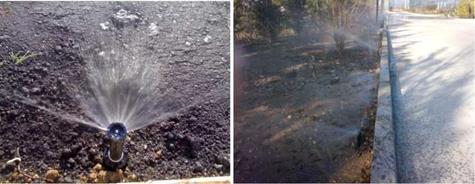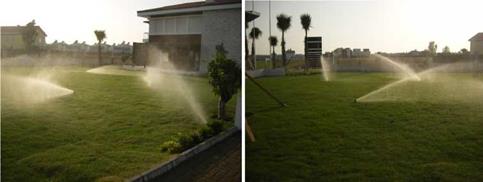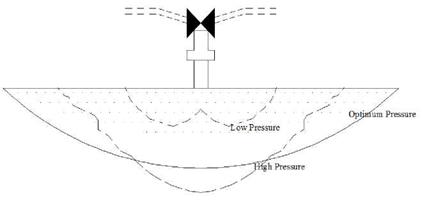The most important parts of sprinkler irrigation system are certainly sprinkler heads. Sprinkler heads are placed at certain intervals over laterals. As well as sprinkler heads is placed on a riser over lateral, they are generally embedded underground in landscape irrigation and known as pop up. Pop up heads do irrigation, moving over soil surface when water is given in system. There is two type of sprinkler heads divided as spray and rotor. Spray heads irrigating without turning are used for confined space (Figure 4). Wetting dimensions of them are 2-4.5 m and working pressures are 1-3 bar (Orta, 2009). Spray heads throw water in higher amounts in more narrow space as compared to rotor. Rotors are used in wider areas with lower precipitation rate (Figure 5.). Rotor type heads are generally used in landscape irrigation. Unit price of spray heads are lower as compared to price of rotor heads but facility costs of sprays are higher as compared to the ones of rotors. Factors such as soil infiltration rate, type of plant, wind conditions, limitations of pressure, demands of owner of system should be taken into account in choice of heads. Also, lowest flow of system, low operating pressure and widest spacing of sprinkler head are considered while making a choice between heads which can meet necessary requirement of water in system. Technical properties related to pop up head are presented in schedule (Table 1).
4.1.4 Water distribution in sprinkler irrigation method
Water throws towards to air at a certain angle in sprinkler irrigation. As a result of this, head as being in center, causes a circular area to be wetted. This area is called as wetting area of sprinkler head. Big water grains drop around head during irrigation and size of water grains dropping over soil get smaller as head goes far. Each head constitute a water distribution depending on dimension of orifices over which each head is equipped and operating pressure (Melby. 1995). In case of head pressure’s decreasing under optimum pressure or increasing it causes deformation of water distribution in Figure 6. Changes of water distribution under different pressures are given Figure 6.
|
Fig. 4. Samples of using spray |
|
Fig. 5. Samples of using Rotor |
It is not possible to provide uniform distribution in irrigating area by singular heads in sprinkler irrigation system. Uniform distribution is obtained by using more than one heads. Factors which affect water distribution are the sprinkler nozzle, operating pressure, flow rate, speed & uniformity of rotation, spacing of the sprinklers, pattern of the sprinkler grid and wind. What is required to be done after choice of appropriate head by purpose of providing uniform distribution is defining sprinkler pattern and sprinkler space. Heads are commonly lay out in shapes of triangle, square and rectangular. Triangular shape is used most commonly in landscape irrigation. In choice of triangular shape better water distribution is obtained in areas having equilateral triangle as compared to square shape. Water disposal is obtained in decreasing waste water due to its water distribution pattern ‘s being better as compared to square shape. Head in less numbers are used since sprinkler heads are placed to more distant area in triangular shape. Triangular shape presents better performance in irregular areas as compared to square shape (Melby. 1995). Another factor is distance between heads. For a good water distribution head intervals on lateral shouldn’t be more than 50% of dimension of wetted area. Also lateral intervals affect water distribution.
Lateral intervals in line of main pipes shouldn’t be over 65% of wetting area. Technical charts presented by producing company are available for each head. In these charts head flows and wetting area in different orifice dimensions and operating pressure are stated. These charts are used in choice of appropriate heads in irrigation area (Yildirim. 2008).
|
Nozzle Model |
Pressure (Psi) |
Radius (m) |
Flow (l/min) |
Precip. Y (cm/h) |
Precip. Д (cm/h) |
|
360° |
1.4 |
2.1 |
6.51 |
6.58 |
9.59 |
|
2.1 |
2.1 |
8.06 |
8.13 |
9.40 |
|
|
2.8 |
2.7 |
9.39 |
9.47 |
10.95 |
|
|
3.4 |
2.7 |
10.52 |
10.62 |
12.27 |
|
|
270° |
1.4 |
2.1 |
5.15 |
6.93 |
8.0 |
|
2.1 |
2.7 |
6.25 |
8.41 |
9.70 |
|
|
2.8 |
2.7 |
7.15 |
9.63 |
11.13 |
|
|
3.4 |
2.7 |
8.06 |
10.85 |
12.52 |
|
|
180° |
1.4 |
2.7 |
3.29 |
6.65 |
7.67 |
|
2.1 |
2.7 |
4.05 |
8.18 |
9.45 |
|
|
2.8 |
2.7 |
4.66 |
9.40 |
10.85 |
|
|
3.4 |
2.7 |
5.22 |
10.54 |
12.17 |
|
|
90° |
1.4 |
2.7 |
2.0 |
8.10 |
9.35 |
|
2.1 |
3 |
2.42 |
9.78 |
11.30 |
|
|
2.8 |
3 |
2.73 |
11.00 |
12.70 |
|
|
3.4 |
3 |
2.95 |
11.91 |
13.77 |
|
Table 1. Technical schedule related to pop up head |
|
Fig. 6. Water distribution histogram obtained under different operating pressures (Gungor et. al. 2010). |
Since sprinkler heads make irrigation by throw water towards to air at a certain angle they are highly affected from windy air conditions. By aiming at obtaining the best distribution in windy conditions by irrigation system a number of arrangements in choosing of sprinkler are required (Barrett et. al. 2003). These arrangements may help to perform a better distribution since water which is sprinkled from less wetting scale heads drop closer area and their interaction with contact of wind is less in areas which are exposed to wind excessively. Having the smallest throw angle should be used. Optimal throw angle is 32° for sprinkler irrigation under normal circumstances. However it is required to reduce this angle in windy conditions. Adjusting throw angle as 22-27° in areas where wind speed is higher than 2.6 m/ sec shall give better results. However heads are required to be placed in a closer area for corresponding water distribution since fire distance is decreased in this case. Also laterals should be placed vertical to wind direction.
Water distribution uniformity is a parameter that questions situation of hydration of irrigated area with corresponding amount of water. This parameter is one of the main factors which is useful for decreasing system costs thanks to consume of less electric, water, fertilizer and pesticide in connection with its irrigation performance. Different parameters are used by purpose of determining uniformity of water distribution. Parameters which are commonly used are sprinkler uniformity Christiansen’s coefficient of uniformity (CU), Distribution Uniformity (DU) and Scheduling coefficient (SC).






